Lucky Bamboo is a popular beginners houseplant. This is a very easy plant to care for, widely available and looks so cute as home decor. It can be pruned into many different shapes and sizes. When planted outdoors and left alone it grows as a leafy bush and may even produce blooms.
You will see Lucky bamboo sold in many forms. It is most often sold chopped short and tied in various ways. The stems may be Straight, curly, braided or even heart shaped.
The stems are often tied together with small leaves sprouting out in various directions. It’s an interesting, eye catcher that will grace your home with a unique, whimsical appeal.
Are lucky bamboos actually bamboo? No. True Bamboos are in another family of plants. One way to tell true bamboo apart from the Lucky bamboo. Lucky Bamboo has fleshy rather than hard stems like true bamboos.
Dracaena sanderiana looks like it came out of Asia with its bonsai like appearance. However, it is actually a perennial herb native to central Africa.
How Long can Lucky bamboo live?
Lucky Bamboo plant has a life span of around two years if grown hydroponically. Expect several years more lifespan if you put it in an ideal plant soil mix and take good care of it.
At maturity, this Dracaena grows to about 3 feet tall. It enjoys dappled moderate to bright light. But also survives low light conditions quite well. Long hours a day of harsh, direct bright sunlight will result in yellowed or burned leaves.
This is a durable plant used to living in tough conditions. In fact, lucky bamboo can survive just about anything you do to it. Except! Constant over watering.
Water your Lucky bamboo when it is almost dry. And then don’t water again it until it almost dries out. A weekly watering schedule is recommended.
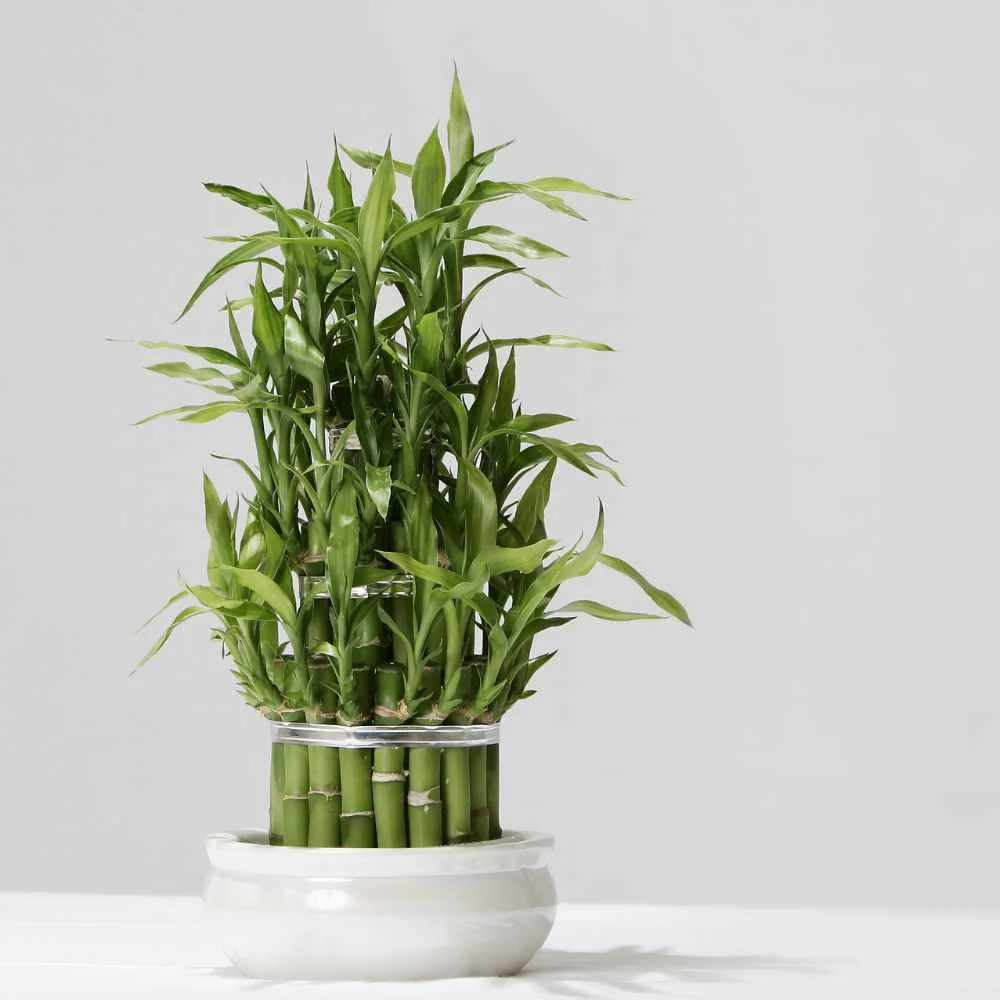
Draceana sanderiana loves moderately dry air rather than high humidity. If you see brown tips on the leaves it wants more humidity. Pebble trays and plant groupings will often add enough humidity for this plant.
This is a quirky, cute, and interesting plant and will tolerate many light conditions in your home. It can be grown either in soil or water.
Does Lucky Bamboo prefer Soil Or Water?
Lucky bamboo prefers to grow in soil. It will have a longer life if it is well maintained in soil, rather than grown in water with hydroponic fertilizer.
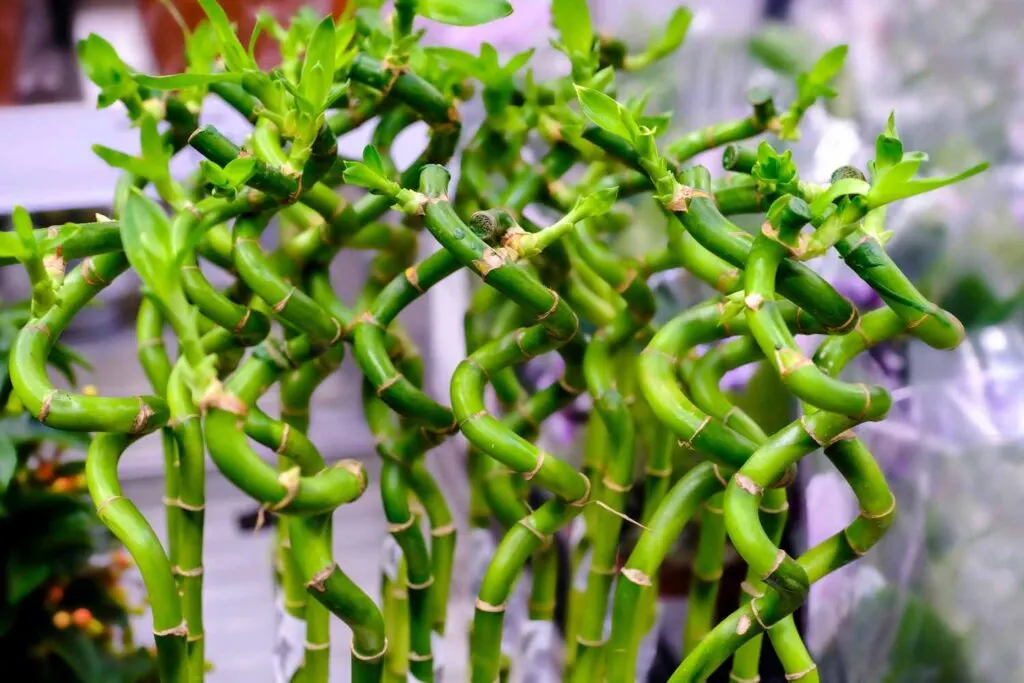
Planting Lucky Bamboo in Soil:
Like all Draceana plants, Lucky bamboo needs very well drained soil. We use a soil mix of 50% regular potting soil with 50% inorganic compounds like perlite or pumas rock.
Grow Lucky bamboo outdoors in climate zones 10 or 11. Planted in well draining garden soil it will grow well and eventually may even produce flowers.
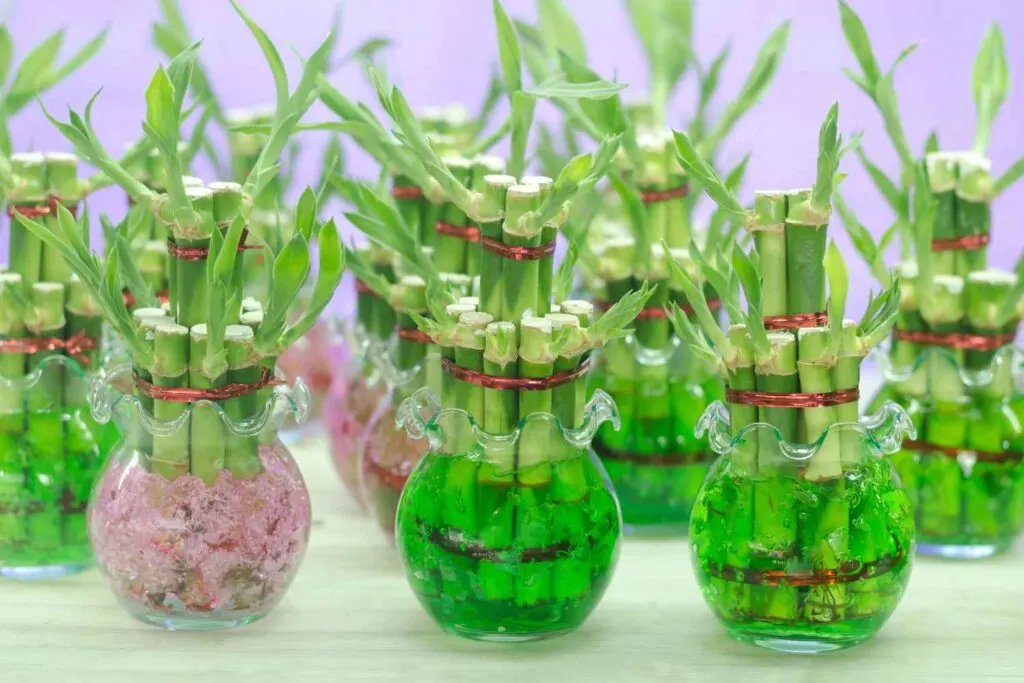
Growing Draceana Sanderiana in Water:
This plant is often grown in water indoors. Many plant shops sell sanderiana in planters with rocks, pebbles and water rather than soil. Sanderiana will live in water about two years. For longer life plant it in soil.
If you choose to grow lucky bamboo hydroponically you will need a good hydroponics fertilizer. I use General Hydroponics flora series of nutrients. It has three separate bottles of nutrients so you can adjust the nutrients to suit the plant and time of year.
I have been growing plants in LECA using this nutrients system over a year now and they all do well on it. Sanderianas will also grow well in LECA if you want to give that a try.
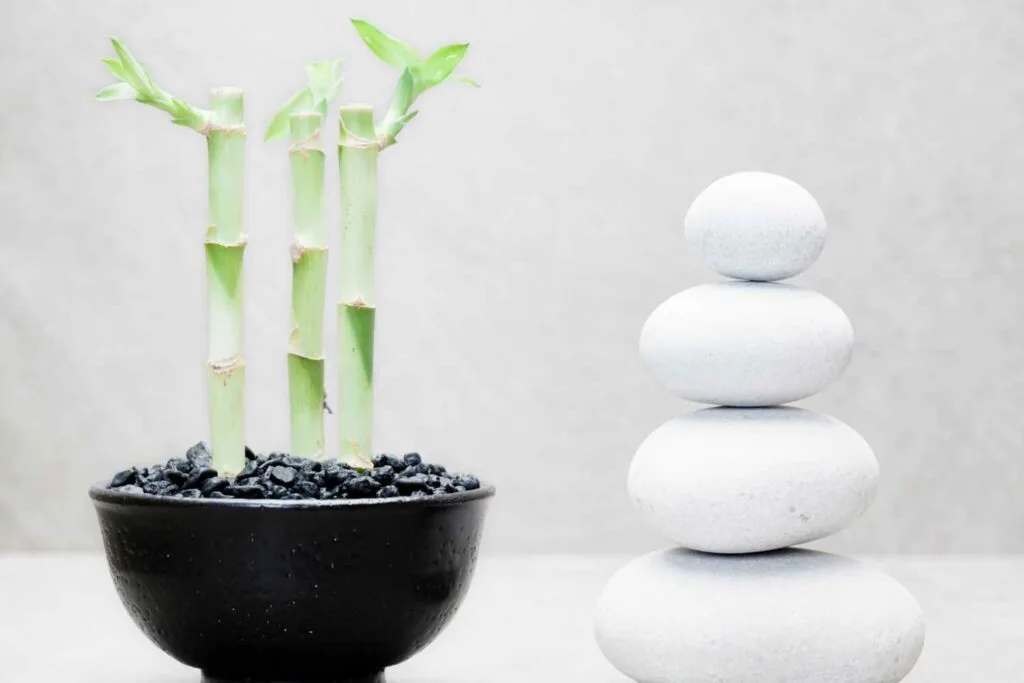
Lucky Bamboo for Feng Shui:
Feng Shui is a creative way to use and manipulate the energy in our homes and environment for spiritual satisfaction. Weather is works or not I leave up to you.
Like the Money tree, Lucky Bamboo is one of the indoor plants often used and associated with positive energy and is often used in Feng Shui decorating.
The way the plant is pruned, how many stems it has and placement in the home all have import to Feng Shui decorators.
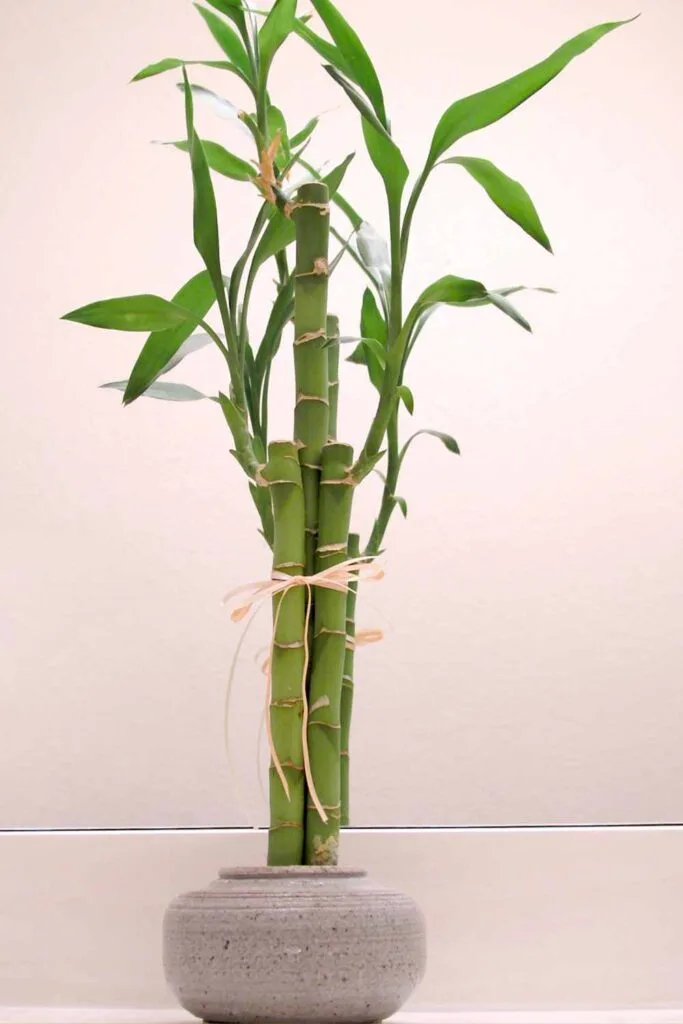
Sourcing This Plant:
You can find lucky Bamboo in almost all plant shops and garden centers. The bigger question is do you like what you see? If not, Go to Etsy for a myriad of pruning styles and choices. Etsy also has a large variety of sizes, and eclectic or Feng shui style planters.
Growing Lucky Bamboo Outdoors:
Lucky bamboo can grow well in climate zones 10 or 11 outdoors when planted in dappled sunlight or light shade in well drained soil.
As you see pictured below it looks quite different when allowed to fully leaf and grow unpruned. Expect it ro get about three feet tall and it eventually may bloom.

How do you care for a lucky bamboo plant?
Here is our ‘at a glance’ care table for Dracaena sanderiana. It really is an easy care houseplant. With this information table and our in depth printable care guide you will have all the information you need to keep your lucky bamboo healthy.
| Familiar Names | Lucky Bamboo |
| Scientific Name | Dracaena sanderiana |
| Plant Family | Asparagaceae-Native to Central Africa |
| Care Difficulty | easy |
| Temperature | 65 to 90 degrees F. |
| Watering | if planted in soil, keep soil lightly moist. Check weekly and use water that is chemical free. |
| Soil | Lucky bamboo needs well drained soil. |
| Lighting | Bright indirect lighting preferred. Tolerates moderate and even low light. Avoid bright harsh sunlight. |
| Flowering | Mature Lucky bamboo blooms when grown outdoors in ideal conditions. Do not expect to see flowers indoors. |
| Growth | Dracaena sanderiana grows as a small bush, (often pruned severely as a houseplant), to about 3 feet tall. Outdoors it grows as a leafy bush. |
| Propagation | Stem cuttings are the best method of propagation. Either in soil or water. |
| Toxic Plant | Lucky bamboo is toxic to cats and dogs. Read more about the symptoms here. |
Here is our printable plant care guide. It covers all the information you need to keep your sanderiana plant content for years.
Lucky Bamboo Care Guide
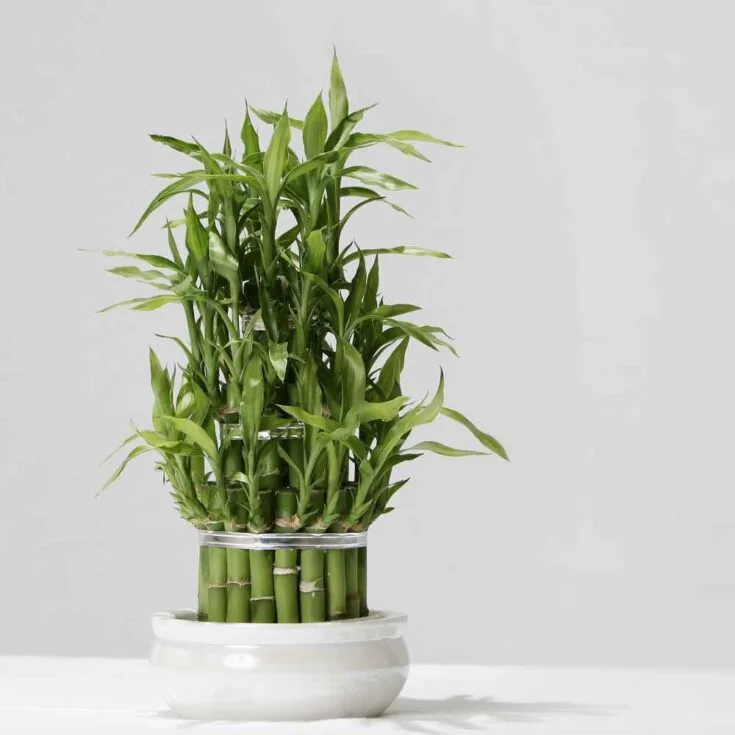
Dracaena sanderiana, or lucky bamboo Plants have only a few basic requirements to remain a happy durable plant.
This interesting bamboo look alike is a perfect beginner houseplant. This plant will grow well outdoors in climate zones 10 and 11..
Materials
Instructions
Soil Preference:
- Lucky bamboo plant enjoys a light well draining soil.
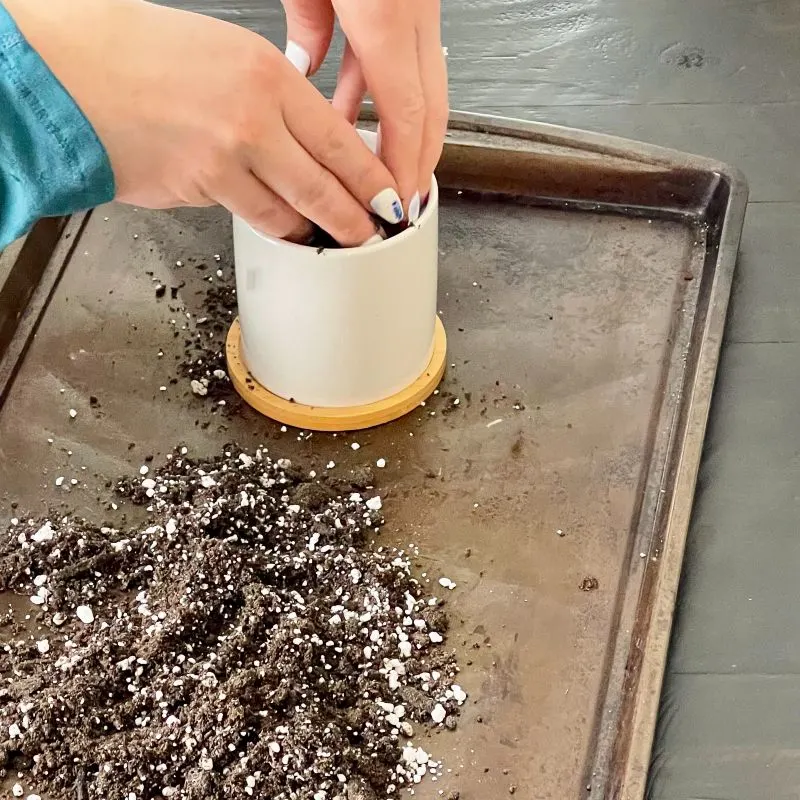
- A mix of potting soil and perlite will keep the roots happiest.
- Our mix for this plant is 50% potting mix to 50% perlite.
- A heavy soil potting mix is not recommended for these plants.
Pot Size and Type:
- This plant will grow to the size of its pot. They can tolerate being root bound.
- If you want to encourage faster growth choose a pot about 2 inches wider in diameter than the current pot.
- Any well drained pot can be used. It MUST have drainage if growing in soil.
- Repot every second year or when roots come out the drainage holes on the pot bottom To the next pot size up.
- Don't jump to a huge pot from a small one unless you wish to encourage faster growth. Just go to the next size up pot.
- IF growing this plant in water: choose a vase or container about inch larger around than your plant roots. This gives the roots enough room to grow.
- Transparent vases will encourage algae growth which is unsightly and not ideal for the plant roots either. Algae can attach to plant roots and suffocate them. For best growing conditons choose a pot that will not let light get to the water.
Lighting:
- Dracaenas enjoys indirect moderate to bright light.
- However, It will tolerate lower indirect light. If the light is too low the leaves will begin to fall. The plant will get leggy and thin as it stretches to the light. Move to brighter light.
- Shield this plant from strong direct light in summer south and west sunny windows. The leaves may burn. Look for yellowing bleached leaves or dry brown spots. If you see them move the plant to lower light.
- Tip: Window sheers or blinds can offset some brief periods of high direct light.
Watering:
- Lucky bamboo is VERY sensitive to the chemicals found in tap water. Use filtered or distilled water to be on the safe side.
- Water your lucky bamboo plant when the soil is dry down two inches or more. Try a watering schedule of once every week.
- Watering is best done on a regular schedule so the plant is not over or under watered. Both can cause stress on the dracaena.
- This tropical plant enjoys moderate humidity. For a really dry climate use pebble trays or group plants close together for increased humidity.
- humidifiers and Misting are normally unneccessary for this plant.
- In dormant winter months reduce watering to when the soil is dry down halfway or more .
- Never let this plant get wet feet when growing in soil. If the soil is compacted the bottom of the soil can remain wet which encourages root rot and Fungus Gnats. If you see yellow leaves or black mushy stems you are overwatering.
Growing Lucky Bamboo in Water:
- When potting hydroponically, make sure you don't get water too far up the stem. Just cover the plant roots. Deep water up the plant stem will rot the stem.
- If you choose to grow lucky bamboo in water you will need a good hydroponic fertilizer. We use this one.
- Your water must be chemical free. This plant prefers acidic conditons so if you have alkiline water you will need to adjust the PH with PH down.
- You can easily test and monitor your tap water PH with this kit. Your plant water should be nuetral to acid. 6 to 7 on your test results.
- GREEN ALGAE: Plants grown in water get algae occasionally and then the pot, rocks and roots need cleaning. A slight case of green algae is not a problem. But if the roots get consumed in algae they will suffocate and rot.
- To prevent algae growth you can buy algaecides, like this one. It is considered plant pet and fish safe.
- If you don't want to use chemicals to clean off the algae you will periodically need to check your pot and if necessary unpot the plant and clean the plant roots as needed, the substrate your are growing the plant in (rocks, leca ect) and the pot itself.
- To discourage algae in a hydronpnics system, use a container that will not translae sunlight into your pot. Pottery pots and Ceramics are a good choice. They are thick materials that wont accept light. Glass or other transparents will allow algae to grow.
- Black algae, discolored or bad smelling water indicates a problem in your hydroponic pot. Most likely root or stem rot. Unpot the plant, trim all black and mushy roots and discard mushy black stems. Sanitize the pot and growing medium. Repot the pruned plant into fresh newly cleaned pot with fresh water and monitor closely for the next few weeks to make sure the problem is taken care of.
How to Fertilize:
- Apply a good quality fertilizer (linked in materials) monthly through Spring and summer.
- Decrease feedings by late Fall and allow your dracaena to rest through the winter months.
- Look for brown spots on the leaves of your plants. This may indicate an over concentration of salts in the roots from over feeding. It can burn the leaves.
- The remedy is to set the plant under a faucet of water and let the water run through for 10 minutes or so. Allow the pot to Completely drain. Discontinue fertilizer until the plant recovers.
Temperature:
- Optimal temperatures for the lucky bamboo are 60 to 90 degrees F. Up to 10 degrees lower night time temperatures are fine.
- They can be grown outside year round in climate zones 10 to 11.
Pruning and Training:
- Pruning will give you a plant with interesting growth patterns.
- These plants can have a single stem or several stems braided and tied like a Money tree.
- The stems may be striaght or curly. The stems will grow towared the light source near them. So to encourage curled stems allow the plant to sit in moderate to low light and seek the light. As the stem twists keep turning the pot so the stem curls.
- Sharp sterile Hand pruners are preferred for pruning. They will give a clean cut that will heal quickly. Cut the leaves back rather than the stems.
- How you prune and tie the stems determines how it grows.
- Growing this plant outdoors is very different. Do Not severly prune it back. Allow the plant to leaf out and grow normally
Table Top size Plants:
- It’s easy to prune and shape these plants to whatever length and fullness you desire. Trim away excess leaves if you wish to highlight attractive stems rather than leaves.But never trim all leaves off. The plant needs leaves to survive.
- As a table top plant cut the longer stems back at the node height you wish to grow it to.
- The top will coninue to grow new growth so you will have to occasionally trim off the growth to your preference.
- Keep the pot size small to keep these plants table top size.
For Taller Bushes:
- The Dracaena sanderiana will grow around 3 feet indoors. If you prefer a shorter bushier plant you will need to trim off the top.
- You can then replant the top next to the taller stem to fill out your bush.
- After pruning the top will send out shoots from each side of the cut at the node. You can let them grow or trim them back as you prefer.
Leaf Care:
- For the best care leaves enjoy occasional washing.
- This helps keep the stomata (leaf pores) open for plant respiration.
- Healthy leaves with a good clean surface are most able to resist pests.
- Dusty leaves will starve the plants of water exchange through humidity.
- Hand Wash with water. or use milk or neem oil to wash clean leaves to create a shiny surface.
Pests:
- We have posts on all the pests listed below. Click the links to learn more about them and how to get rid of various pests on your plants.
- Dracaenas are not fussy and resist pests quite well when in good health. However all plants get attacked by pests.
- Stress by long term poor watering practices, poor light, extreme temperatures and soil conditions are contributors to pests.
- Washing the leaves occasionally will help keep pests from establishing themselves on the plant.
- Spider mites are the biggest problem for many plants. Watch for the webs. Treat immediately and continue for two weeks or more to remove the next generation of spider mites after the adults die. Eggs attach to the leaves and cannot be washed off.
- mealy bugs, scale, thrips and whitefly are also common houseplant pests you will see in a stressed lemon lime plant.
- Read our post on How to get rid of aphids and other pests with our homemade pesticide soap recipe or neems oil.
- To minimize the possibility of pests be sure to check all nursery plants before bringing them home. Read our post on the 7 most common plant pests and how to kill them.
- Quarantine all new plants until you are sure no pests live in them.
How to Propagate Dracaena Sanderiana:
- Propagation is best done through stem cuttings.
- You need a 3 to 6 inch leaf stem with a node and healthy leaf top.
- Cut the stem in between two nodes. Strip off the bottom leaves.
- Place the stem into rooting hormone gel.
- Now plant the stem in moist soil, water or other planting medium.
- Be sure to set the cutting in water to grow it hydroponically. Use the soil method for growing it in soil. The roots will be different for each medium you choose. Begin as you mean to go on.
- For water propagation change out the water at least once a week or if water gets discolored or cloudy.
- After several weeks roots will grow.
- For soil propagations: Make sure to keep the soil moist until the roots begin to set into the soil.
- Once roots form, visible in the water jar, plant the plant in its final container.
- If you are planting a water propagation into soil the plant will have to transistion to soil roots. It can do this but it will take more time. Watch the plant and keep the soil moist as it transitions to soil roots.
- Watch our video below on. plant propagation methods. The dracena lemon lime and lucky bamboo are propagated similarly to my Dwarf Umbrella in this video.
Toxic Plant:
- This plant contains Saponins which are toxic to humans and pets.
- This is a medium toxin and non lethal.
- Symptoms: weakness, drooling, vomiting, diarrhea and depression. Be aware, Contact your vet if symptoms persist. Dehydration is deadly to small pets.
- Poison Part: Leaves and stems
Related Content:
Looking for more ideas on houseplants? These three are very easy care. Two of them are relatives of the lucky bamboo and the Peace lily is always fun to place in your home and watch it bloom.
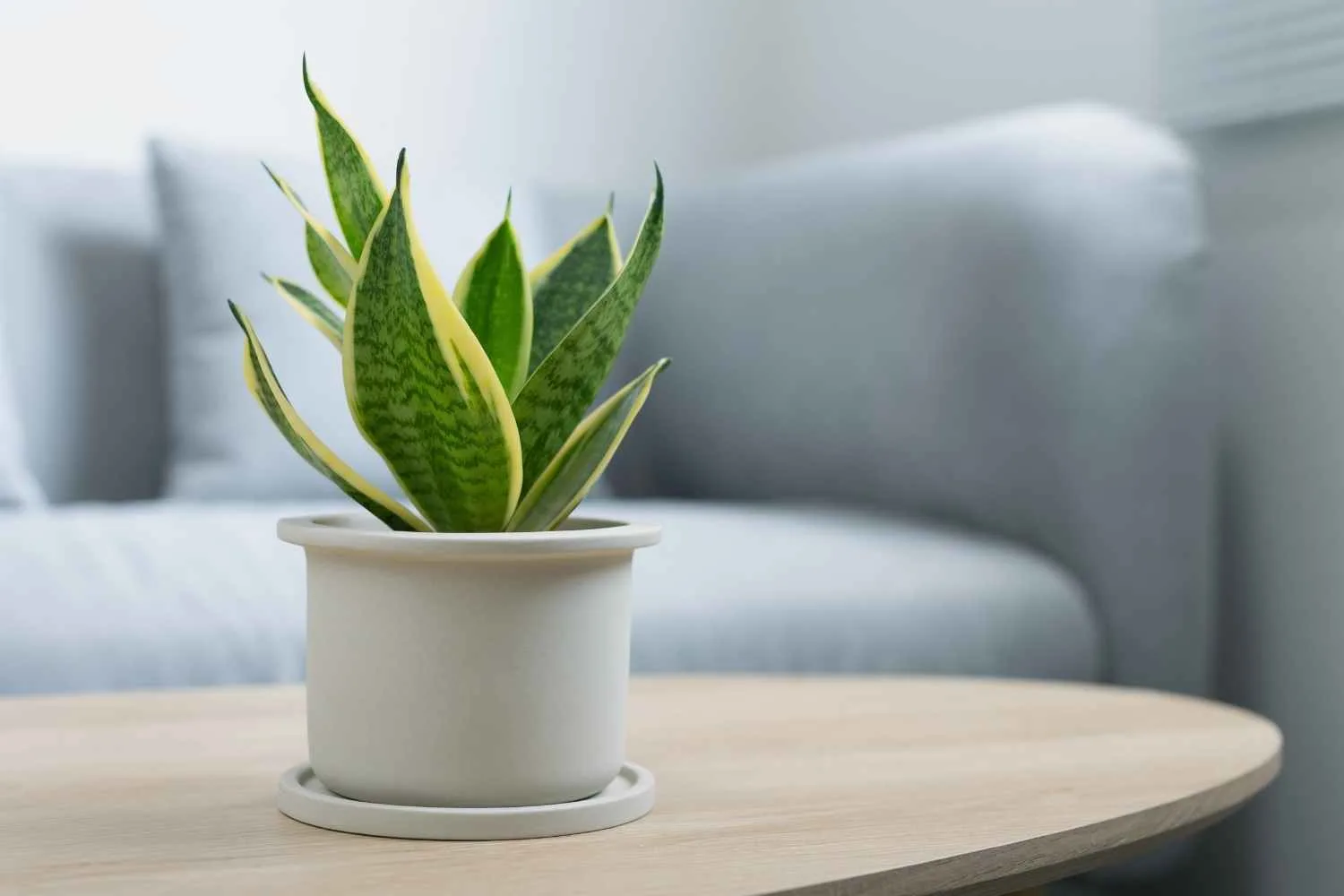
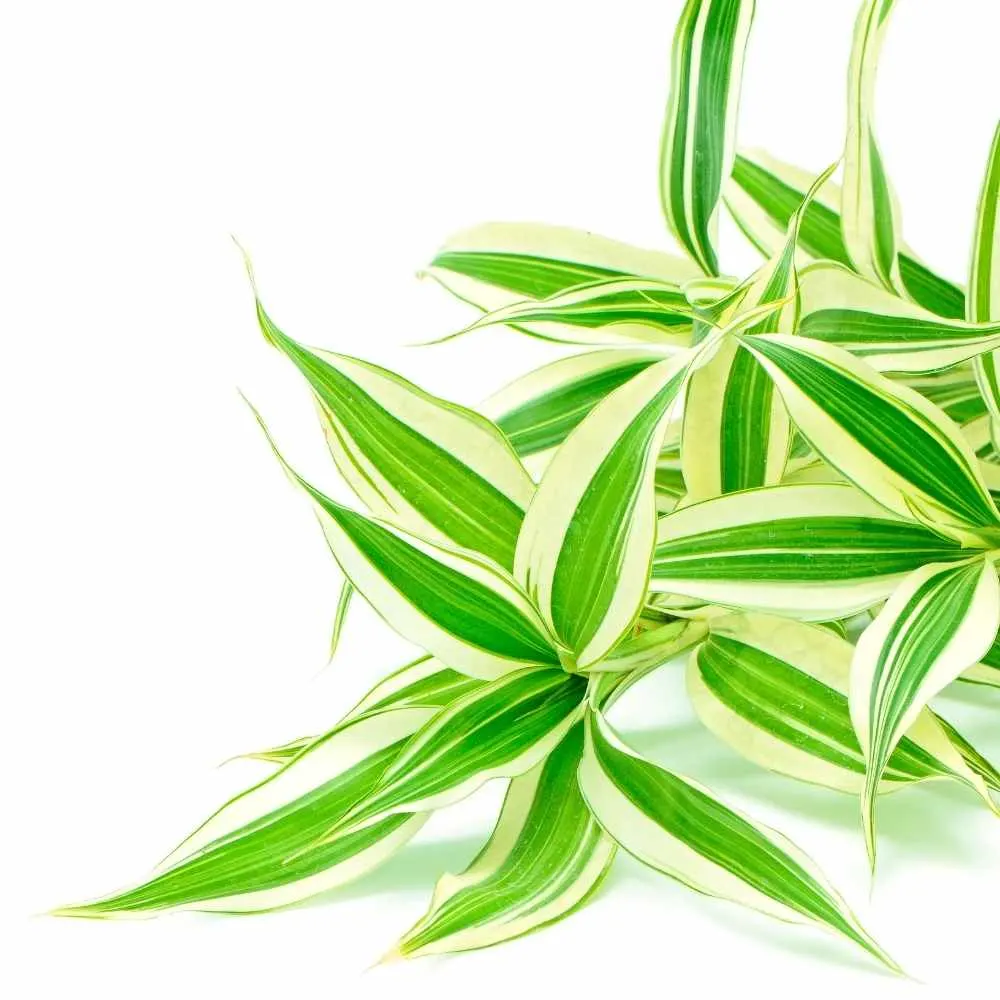
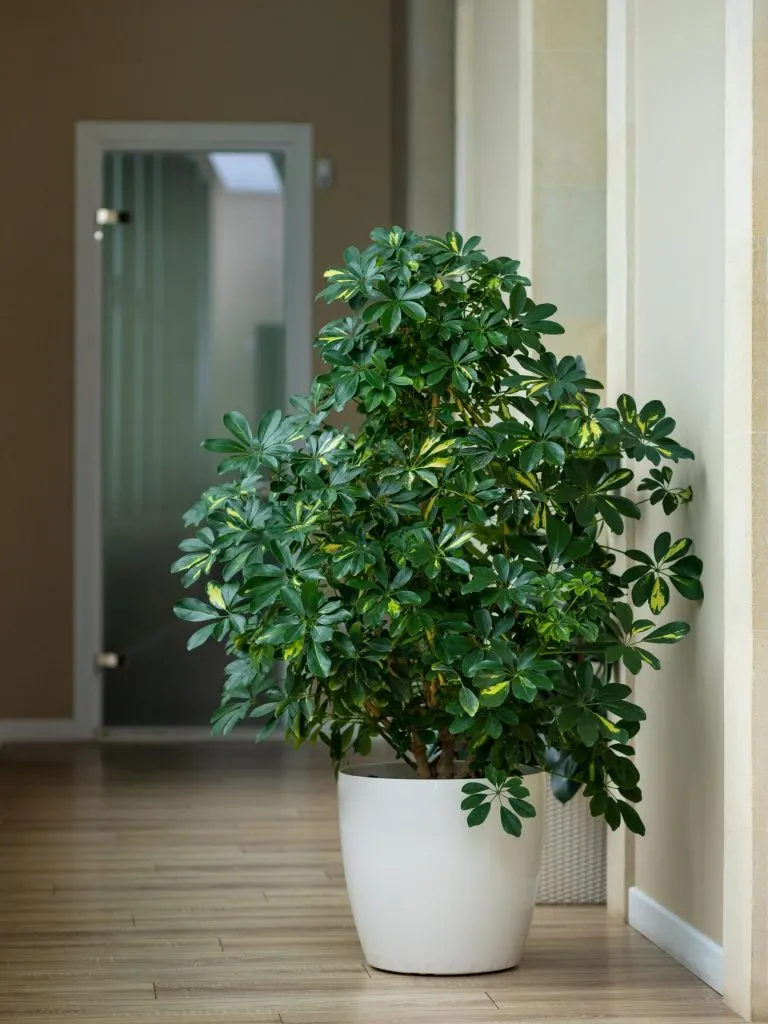
Follow Us:
Find us on YouTube, Instagram , Pinterest and TikTok! We love to Plant chat. We also comment, like and occasionally share your content to our daily stories. We’d love to see your plants. Share your joy in your houseplants. Happy Planting!

